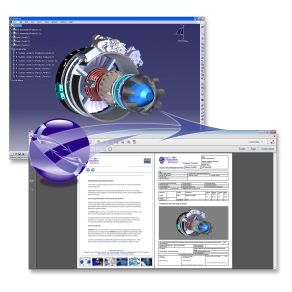Our latest version of our Publish 3D-3D PDF solution continues to provide an easy to use, low cost solution which enables the integration of departments, customers and suppliers into the product lifecycle process.
When the product lifecycle is at the manufacturing stages, it is essential that staff have all the necessary pieces of information that are required to put in place the manufacturing processes needed for production.
Most of this information will be passed down from the design engineers, who will have designed the product using a CAD system. But the manufacturing engineers need more than just the design visual, they need the rest of the product information, such as dimensions and materials etc. and unless they know how to use a CAD system, they may have difficulty in accessing and understanding it. Sharing data in its native digital form requires specialist resource and training. The more traditional paper route can equally be as problematic. Both routes can be expensive and time consuming and often require input from Engineering to make sense of the data.
Our Publish 3D – 3D PDF suite of products addresses these issues using Adobe’s standard PDF Reader, which is already in use in most organisations globally.
With the introduction of our Publish 3D – 3D PDF into any organisation, the processes of sharing design data are instantly enhanced and simplified, helping to improve communication and reduce any ambiguity based around product design data.
What is Publish 3D?
Publish 3D is a software application that enables the publishing of 3D CAD data directly from within the design application, alongside any associated metadata, into a fully interactive 3D PDF document. It is a fully integrated solution supporting Model Based Definition (MBD) processes, and 3D annotations and dimensions (PMI), for downstream data re-use.
This solution offers enhanced functionality enabling the design author to pass information including PMI, Geometry, Assembly Structure, Metadata, and Visualization attributes directly to the manufacturing department – without the need for a single drawing to be produced.
By creating a 3D PDF document, engineers can pass on CAD data to anyone within manufacturing or tooling who has access to Adobe reader, and they can in turn mark-up, interrogate and annotate the 3D CAD data as per their requirement and then create process plans and works instructions containing the 3D content.
Features of a 3D PDF
Using the Adobe toolbar you are able to:
- Explode views
- Show attribute information
- Manipulate 3D data using zoom, pan and rotate
- View product structure tree and hide/show different items within that structure
- Include attachments so that a complete technical data package can be created
- Manually mark-up and annotation
- Cross section parts
- Change the graphics for the 3D data using Model Rendering
- Change lighting, background colour, text colour etc.
- Control of the 3D geometry content using tessellated representations.
A number of widgets, such as carousels, tables, check boxes and drop down lists are also available.
Why use 3DPDF’s and Publish 3D in Manufacturing?
Working directly from within a CAD design session, Publish 3D supports the creation of documentation into the 3D PDF format, combining interactive 3D design data representations with full Product Manufacturing Information (PMI). 3D PDF documents can be used during the manufacturing process, removing the requirement for 2D drawings to be output from the CAD source data.
Using 3D PDF allows a more thorough understanding of the product due to different views being available for interrogation, along with dimensional, tolerance, and surface finish information. Additional information can be attached to the 3D PDF document (such as spreadsheets, hyperlinks, AVI’s etc.). You can then use the 3D image embedded and any additional data, such as quantities, and cost information, and lists of raw materials, to create a MBOM, which can be shared throughout the organisation and the supply chain.
And in Tooling?
With key dimension and tolerance information displayed alongside a variety of different view options, the 3D image embedded in the document and any additional data can be used in the creation of tool design and any other technical documents you may need to produce, which can then be shared easily as a compressed file via email.
How can this benefit Manufacturing/Tooling?
The benefit of this new technology is in its simplicity of deployment and ease of use, removing barriers to integrate with the manufacturing/tooling departments. The IP of the native CAD data is also protected in the 3D PDF format but data can still be exchanged. Passwords can also be set on the documents so that only certain people of your choosing can access the data. With everyone in manufacturing or tooling needing 3D data to support and drive their processes then having 3D content in documents is key for strategic advantage in an increasingly competitive market, and leads to reduced lead times, fewer mistakes and better products.
3D PDF is a great way of leveraging CAD and PLM assets, and a simple and cost effective way of sharing those assets with others.
To learn more about 3D PDF watch our short ‘What is 3D PDF’ video…
http://www.theorem.com/3dpdf/what-is-a-3d-pdf.htm
For more information visit www.theorem.com



 ing PMI, Geometry, Assembly Structure, Metadata, and Visualization attributes directly to the manufacturing department – without the need for a single drawing to be produced.
ing PMI, Geometry, Assembly Structure, Metadata, and Visualization attributes directly to the manufacturing department – without the need for a single drawing to be produced.